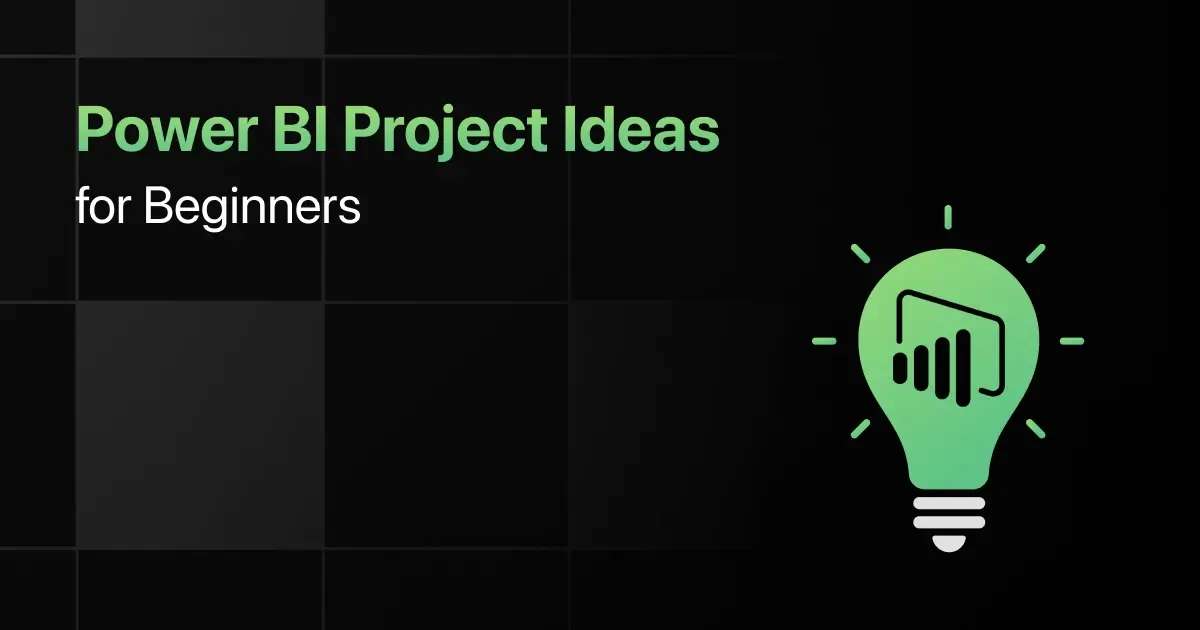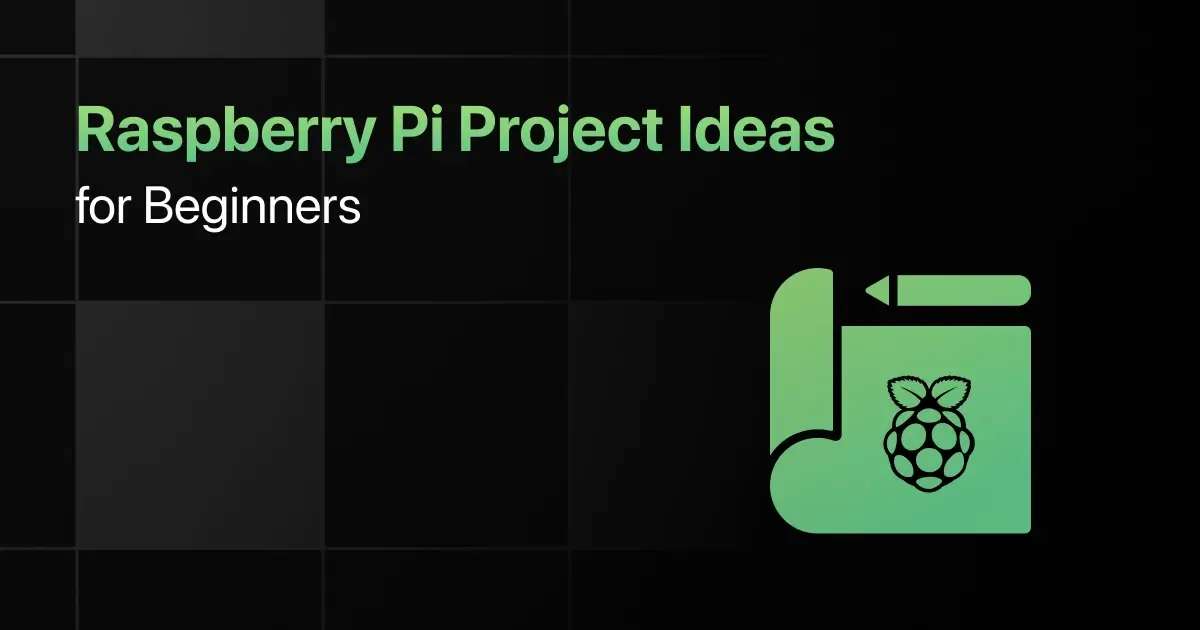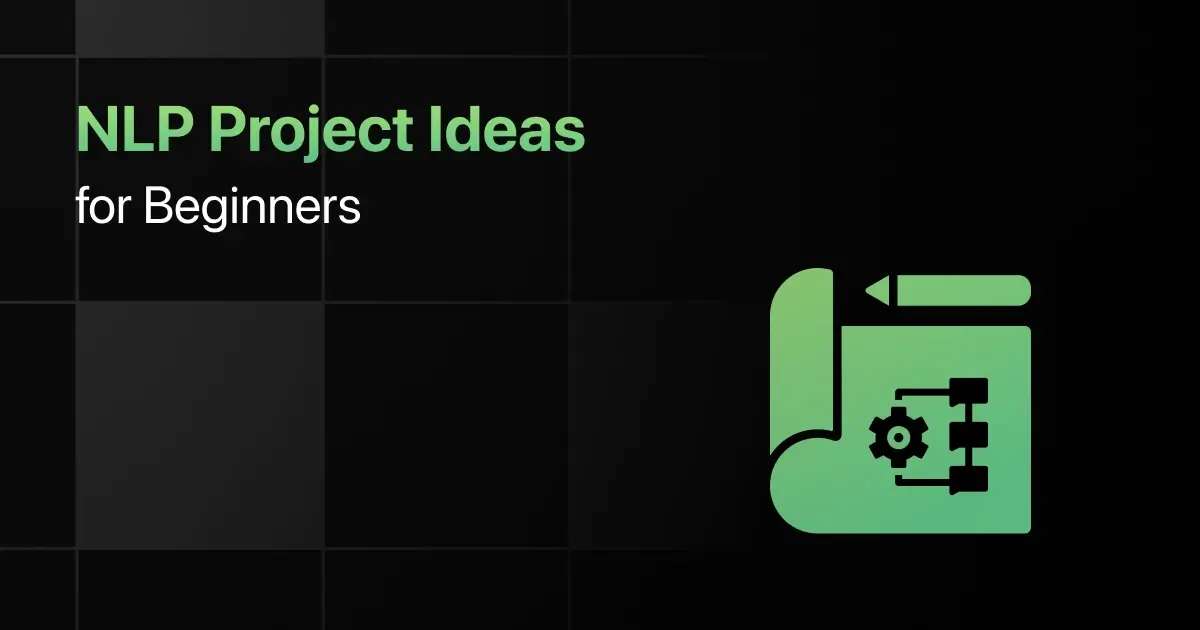Best Power BI Project Ideas for Beginners

Are you a beginner in the field of data analysis, eager to learn Power BI? Then you are in the right place.
In this guide, we will explore a curated list of 10 best Power BI projects for beginners with source code which can be a great starting point.
10 Beginner-Friendly Power BI Project Ideas – Overview
Here’s an overview of the 10 best Power BI projects for beginners:
| S.No. | Project Title | Complexity | Estimated Time | Source Code |
|---|---|---|---|---|
| 1 | Sales Data Analysis | Medium | 15 hours | View Code |
| 2 | Customer Churn Data Analysis | Medium | 15 hours | View Code |
| 3 | HR Data Analysis | Medium | 15 hours | View Code |
| 4 | Anomaly Detection in Credit Card Transactions | Easy | 15 hours | View Code |
| 5 | Heart Disease Analysis | Medium | 15 hours | View Code |
| 6 | Airline Delay Analysis | Medium | 16 hours | View Code |
| 7 | Climate Change Dashboard | Medium | 20 hours | View Code |
| 8 | IT Spend Analysis | Medium | 20 hours | View Code |
| 9 | Marketing Campaign Data Analysis | Medium | 20 hours | View Code |
| 10 | Supply Chain Management | Medium | 20 hours | View Code |
Top 10 Power BI Projects for Beginners
Below are the top 10 simple Power BI projects for beginners:
1. Sales Data Analysis
This is one of the Power BI mini projects that is focused on leveraging sales data to uncover insights through analysis, visualization, and reporting. In this project, you will learn how to use Power BI to transform raw data into actionable intelligence.
Duration: 15 hours
Project Complexity: Medium
Learning Outcome: Understanding of data modeling, DAX formulas, and interactive dashboard creation in Power BI
Portfolio Worthiness: Yes
Required Pre-requisites:
- Basic understanding of data analysis concepts
- Familiarity with Excel or similar spreadsheet tools
- Interest in data visualization and business intelligence
Resources Required:
- Power BI Desktop
- Sample sales data (CSV or Excel format)
- Access to Power BI service for publishing (optional)
Real-World Application:
- Enhancing business decision-making by identifying sales trends and patterns
- Improving sales strategies and operations based on data-driven insights
2. Customer Churn Data Analysis
This project revolves around analyzing customer churn data to identify key factors that lead to customer attrition. By delving into this analysis, you’ll learn how to use various analytical tools and techniques to predict customer behavior and develop strategies to increase customer retention.
Duration: 15 hours
Project Complexity: Medium
Learning Outcome: Understanding of predictive modeling, data preprocessing, and visualization techniques to analyze customer churn
Portfolio Worthiness: Yes
Required Pre-requisites:
- Basic understanding of statistics and predictive modeling
- Familiarity with a programming language (Python/R)
- Knowledge of SQL and database concepts
Resources Required:
- Data analysis software (Python/R with relevant libraries such as pandas, scikit-learn, matplotlib)
- Customer churn dataset (usually in CSV format)
- Jupyter Notebook or RStudio for code documentation and presentation
Real-World Application:
- Predicting and reducing customer churn in telecommunications, banking, and subscription-based services
- Enhancing customer relationship management by identifying at-risk customers and tailoring retention strategies accordingly
3. HR Data Analysis
This project involves analyzing human resources (HR) data to uncover insights related to employee performance, turnover, satisfaction, and recruitment strategies.
Through this analysis, you will learn to apply statistical and machine learning techniques to HR data, helping organizations make informed decisions to improve workforce management and organizational culture.
Duration: 15 hours
Project Complexity: Medium
Learning Outcome: Understanding of data cleaning, statistical analysis, predictive modeling, and visualization techniques in the context of HR analytics
Portfolio Worthiness: Yes
Required Pre-requisites:
- Basic knowledge of statistics and machine learning concepts
- Familiarity with a programming language like Python
- Understanding of HR processes and challenges
Resources Required:
- Data analysis software (Python with libraries such as pandas, numpy, scikit-learn, matplotlib/seaborn)
- HR dataset (can include employee demographics, performance ratings, turnover data, etc.)
- Jupyter Notebook for code and findings documentation
Real-World Application:
- Identifying factors that contribute to employee turnover and developing strategies to improve retention
- Analyzing employee performance data to inform training programs and promotion paths
4. Anomaly Detection in Credit Card Transactions
This project focuses on identifying fraudulent or unusual transactions within credit card transaction data using anomaly detection techniques. Through this analysis, you will learn to apply machine learning algorithms to spot outliers that deviate significantly from the norm, which could indicate fraud.
Duration: 15 hours
Project Complexity: Easy
Learning Outcome: Understanding of anomaly detection algorithms, data preprocessing techniques, and the application of machine learning models for fraud detection
Portfolio Worthiness: Yes
Required Pre-requisites:
- Strong understanding of machine learning concepts
- Proficiency in Python and libraries like pandas, scikit-learn, and TensorFlow/Keras
- Familiarity with concepts of financial transactions and fraud
Resources Required:
- Python development environment
- Credit card transaction dataset (often anonymized due to privacy concerns)
- Machine learning libraries (e.g., scikit-learn, TensorFlow/Keras for building and evaluating models)
Real-World Application:
- Enhancing the security of financial transactions by detecting and preventing credit card fraud
- Reducing financial losses for both consumers and financial institutions by promptly identifying fraudulent activities
5. Heart Disease Analysis
This project entails analyzing data related to heart disease to identify key indicators and predictors of cardiovascular conditions. By engaging in this analysis, you will learn how to use data science tools and techniques to uncover patterns and correlations that can help in predicting heart disease.
Duration: 15 hours
Project Complexity: Medium
Learning Outcome: Understanding of data preprocessing, exploratory data analysis, and machine learning model development for health data
Portfolio Worthiness: Yes
Required Pre-requisites:
- Basic knowledge of statistics and machine learning
- Proficiency in a programming language, preferably Python
- Familiarity with data manipulation and visualization libraries (pandas, matplotlib, seaborn)
Resources Required:
- Python development environment
- Heart disease dataset (features might include age, sex, cholesterol levels, blood pressure, and other health indicators)
- Machine learning libraries (e.g., scikit-learn for building predictive models)
Real-World Application:
- Assisting healthcare professionals in early detection and prevention strategies for heart disease
- Contributing to personalized medicine by identifying high-risk patients and tailoring preventive measures accordingly
6. Airline Delay Analysis
This project involves analyzing airline delay data to uncover patterns and causes behind flight delays. Through this analysis, you will learn how to use data analytics techniques to dissect the multifaceted reasons for airline delays, ranging from weather conditions to technical issues, and how these factors affect overall airline performance.
Duration: 16 hours
Project Complexity: Medium
Learning Outcome: Understanding of data preprocessing, exploratory data analysis, and visualization techniques to analyze airline delay causes and impacts
Portfolio Worthiness: Yes
Required Pre-requisites:
- Basic understanding of data analysis and visualization concepts
- Familiarity with a programming language like Python or R
- Knowledge of SQL and database handling
Resources Required:
- Data analysis software (Python/R with libraries such as pandas, numpy, matplotlib/seaborn, or ggplot2)
- Airline delay dataset (including reasons for delays, flight durations, distances, airlines, and dates/times)
- Jupyter Notebook or RStudio for code and findings documentation
Real-World Application:
- Assisting airlines in identifying and addressing the most common causes of delays
- Enhancing customer satisfaction by improving on-time performance and communication regarding delays
7. Climate Change Dashboard
This project entails creating a dashboard to visualize and analyze data related to climate change, including temperature anomalies, CO2 emissions, sea level rise, and ice melt. You’ll learn how to use dashboard creation tools like Power BI, Tableau, or a web development framework (e.g., Dash by Plotly for Python) to present complex climate data in an accessible and interactive manner.
Duration: 20 hours
Project Complexity: Medium
Learning Outcome: Understanding of data integration, interactive visualization techniques, and the creation of user-friendly dashboards for displaying complex environmental data.
Portfolio Worthiness: Yes
Required Pre-requisites:
- Basic understanding of data visualization principles
- Familiarity with a dashboard creation tool (Power BI, Tableau, or Dash by Plotly)
- Knowledge of climate change and environmental science concepts
Resources Required:
- Dashboard development tool (Power BI, Tableau, Dash by Plotly)
- Climate change datasets (temperature records, CO2 levels, sea level measurements, etc.)
- Development environment (if using Dash by Plotly or similar)
Real-World Application:
- Providing policymakers, researchers, and the public with accessible information on climate trends and impacts
- Aiding in the understanding and communication of climate change effects to support informed decision-making and advocacy efforts
8. IT Spend Analysis
This project is centered on analyzing IT (Information Technology) spending across different departments or projects within an organization to uncover insights on budget allocation, cost-saving opportunities, and investment optimization. Through this project, you will learn to utilize data analytics tools to process and visualize IT spending data, aiding in strategic decision-making regarding technology investments.
Duration: 20 hours
Project Complexity: Medium
Learning Outcome: Understanding of data manipulation, financial analysis in IT context, and dashboard creation for presenting IT spending insights
Portfolio Worthiness: Yes
Required Pre-requisites:
- Basic understanding of IT operations and budgeting
- Proficiency in data analysis tools (e.g., Excel, Power BI, or Tableau)
- Knowledge of data visualization principles
Resources Required:
- Data analysis and visualization software (Power BI, Tableau, or similar)
- IT spending data (can include hardware, software, services, personnel costs, etc.)
- Access to financial reports or budget documents for accurate data
Real-World Application:
- Optimizing IT budget allocation to support strategic business goals
- Identifying cost-saving opportunities through analysis of spending patterns and vendor performance
9. Marketing Campaign Data Analysis
This project focuses on evaluating the effectiveness of marketing campaigns by analyzing campaign data to identify trends, measure performance against KPIs, and derive insights to optimize future marketing strategies. You will learn how to use data analytics tools and techniques to assess campaign reach, engagement, conversion rates, and ROI.
Duration: 20 hours
Project Complexity: Medium
Learning Outcome: Understanding of key marketing metrics, statistical analysis, and visualization techniques to assess and improve marketing campaign performance
Portfolio Worthiness: Yes
Required Pre-requisites:
- Basic understanding of marketing concepts and metrics
- Proficiency in data analysis tools (e.g., Python/R, SQL)
- Familiarity with data visualization tools (e.g., Tableau, Power BI)
Resources Required:
- Marketing campaign data (e.g., customer demographics, campaign responses, sales conversions)
- Data analysis and visualization software (e.g., Python/R for analysis, Tableau/Power BI for visualization)
- Access to previous campaign performance reports for benchmarking
Real-World Application:
- Optimizing marketing spend by allocating resources to high-performing channels and campaigns
- Enhancing customer targeting and personalization by understanding campaign performance across different segments
10. Supply Chain Management
This project is centered around optimizing and analyzing a supply chain to identify bottlenecks, improve efficiency, and reduce costs. By delving into supply chain management, you will learn how to apply data analytics to streamline operations, forecast demand, manage inventory, and improve overall supply chain performance.
Duration: 20 hours
Project Complexity: Medium
Learning Outcome: Understanding of supply chain analytics, demand forecasting, inventory management, and logistics optimization
Portfolio Worthiness: Yes
Required Pre-requisites:
- Basic understanding of supply chain concepts
- Familiarity with statistical analysis and predictive modeling
- Proficiency in a programming language like Python for data analysis
Resources Required:
- Data analysis software (Python with libraries such as pandas, numpy, matplotlib, and scikit-learn)
- Supply chain dataset (involving inventory levels, supplier performance, shipping logistics, etc.)
- Jupyter Notebook or similar for documentation and analysis
Real-World Application:
- Enhancing decision-making in procurement, inventory management, and distribution to reduce costs and improve efficiency
- Improving customer satisfaction through better demand forecasting and delivery performance
Frequently Asked Questions
1. What are some easy Power BI project ideas for beginners?
Some easy Power BI project ideas for beginners are Sales Data Analysis, Customer Churn Data Analysis, and HR Data Analysis
2. Why are Power BI projects important for beginners?
Power BI projects are important for beginners as they provide hands-on experience with data visualization and business intelligence.
3. What skills can beginners learn from Power BI projects?
From Power BI projects, beginners can learn data modeling, data analysis, creating interactive dashboards and DAX (Data Analysis Expressions).
4. Which Power BI project is recommended for someone with no prior programming experience?
HR Data Analysis project is recommended for someone with no prior programming experience.
5. How long does it typically take to complete a beginner-level Power BI project?
It typically takes 7 to 8 hours to complete a beginner-level Power BI project.
Final Words
Power BI projects provide an excellent opportunity for beginners to learn data analysis and gain practical experience.
With various Power BI project ideas available, beginners can apply their practical skills and enhance their portfolios at the same time.
Explore More Power BI Resources
Explore More Project Ideas
Related Posts

How to learn machine learning
Are you interested TESTING in practically mastering Data Analytics? Then you are in the right place. Data Analytics is the process …





